-
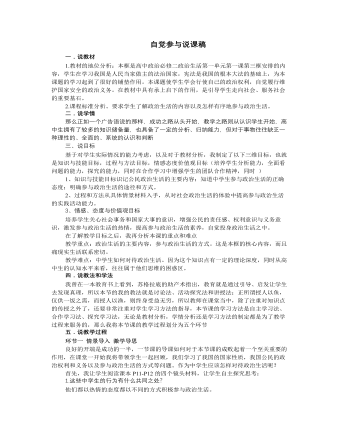
人教版高中政治必修2自觉参与说课稿
1.必须明确政治生活的作用 (政治生活与经济生活、文化生活是相辅相成的。政治生活直接影响到人民民主的实现程度,影响全体人民利益,也会影响我们的经济生活、文化生活。)2.需要学习政治知识 (5个有助于)3.需要参加政治实践活动。 (参加政治实践的途径;参加政治实践的意义)(通过情景问题,形成学生如何参与政治生活的方法;通过解决问题,培养学生解决问题的能力和发散思维的能力。)环节四 课堂小结 巩固知识本节课我采用线索性的板书,整个知识结构一目了然,为了充分发挥学生在课堂的主体地位,我将课堂小结交由学生完成,请学生根据课堂学习的内容,结合我的板书设计来进行小结,以此来帮助教师在第一时间掌握学生学习信息的反馈,同时培养学生归纳分析能力、概括能力。

人教版高中政治必修4生活处处有哲学说课稿
(二)组织学生探究知识并形成新的知识。我从学生的生活体验入手,运用案例等形式创设情境呈现问题,使学生在自主探索、合作交流的过程中,发现问题、分析问题、解决问题,在问题的分析与解决中主动构建知识。主要通过几幅漫画让学生思考其中的哲学道理,开始接触哲学。漫画一:种瓜得瓜,种豆得豆,种鸡蛋得??漫画二:甲:下雨好极啦!乙:下雨糟透了!漫画三:——狂妄之徒,你竟然坏了祖上规矩!在引导学生思考、体验问题的过程中,可以使学生逐步学会分析、解决问题的方法。这样做既有利于发展学生的理解、分析、概括、想象等创新思维能力,又有利于学生表达、动手、协作等实践能力的提高,促进学生全面发展,力求实现教学过程与教学结果并重,知识与能力并重的目标。

人教版高中英语必修1Anne's best friend说课稿
Step 7 Language points 1.Vocabulary (1) go through (2) set down (3) a series of (4) on purpose (5) in order to (6)at dusk (7)entirely (8)face to face 2.Important sentences (1)…I’ve grown so crazy about everything to do with nature. (2)There was a time when … (3)I stayed awake on purpose until … (4)It was the first time … that I’d seen the night … (5)It’s no pleasure looking through … Purpose: 1.Master the required vocabulary and sentence structures. 2.Use them freely. Step 8 Consolidation 1.Find out the topic sentences 2.Retell the text according to the topic sentences Purpose: I want to know if my students understand the text. Step 9 Discussion Imagine you have to go into hiding like Anne and her family, what would you miss most? Giveyour reasons. Purpose: Train Ss’ oral English ability. Step 10 Homework Write an article on Friends. Purpose: 1. Improve the Ss’ writing ability. 2 Train the Ss’ ability of self—teaching and looking up information by themselves. Part 5 Blackboard design(说板书设计)Unit 1 Friendship Reading Anne’s Best Friend 1.Main idea of each paragraph: Para. 1 Anne made her diary her best friend. Para .2 Anne wrote her feelings in her diary. Para .3 Anne missed nature. Para.4 Anne saw the night face to face Para.5 Anne wanted to experience nature outdoors. 2.Listening: Exx.1 P3 3.Discussion: Exx.3 P3 Purpose: 1.Make Ss familiar with the passage 2.Make the design inductive, instructive and artistic.

人教版高中英语必修1English around the world说课稿
(3)v. 给:提出;展现,显现present sb. with sth. ; present sth. to sb. 把. . 交给;颁发;授予present sth. (for sth. )/present sth. to sb. e. g. Om his birthday, his friends presented him a collection of stamps. 在他生日时,他的朋友们送给他一套邮票作为礼物。The sword was presented by the family to the museum. 这家人把宝剑捐赠给了博物馆。The committee will present the final report to Parliament in June. 委员会将在六月向议会提交最后的报告。You need to present yourself better. 你需要更善于展现自己。It is essential that we present a united front. 至关重要的是我们要表现得更加团结。Step 4 ConsolidationT:Now that we have got a general idea of these words and phrases. Lets make up some sentences using them to master them. Suggested sentences:1. Your duties include typing letters and answering the telephone. 2. It is one of the greatest roles that she has played. 3. A large number of people have applied for the job. 4. The number of the panda is declining. 5. I'11 go there, even if I have to walk. 6. He came up to me to ask for a light. 7. The novel is about a family who can't communicate with each other. 8. He based his plan on interests of most people. 9. Why doesn't he make use of his singing talent?Step 5 Summary and homeworkT:Today we dealt with several new words and phrases. After class I hope that youcan read them again and again to keep them in mind. That's all for today. You aredismissed.

人教版高中英语必修1Nelson Mandela--A Modern Hero说课稿
In this step, give students a few minutes to read the passage . While they are reading, I will write some key words of the text on the blackboard. Then ask students to retell the passage according to the key words.By retelling, students can improve their ability of language organization and have an overall understanding of the article.Step 4 Group discussionIn this step, students will be divided into groups of 4 to discussion the following question: What qualities make a great person?After their discussion, invite a few groups to make a report to the class.This group discussion can practice students’ oral English and cultivate their abilities of cooperation and communication.Step 5. HomeworkLet students write a short passage to introduce a great person he or she admires.The homework can consolidate the knowledge the students have learned and cultivate their writing ability. Part 6 Blackboard Design(板书设计)That’s all my teaching procedures. Finally, I’d like to say sth about part 6 blackboard design. On the top is the title. On the left, there will be some new words and expressions. In the middle of the blackboard, I will write some useful sentence structures so that the students can know clearly what they’ve learned and then try to master the knowledge.OK. That’s all for my presentation. Thank you for your attention.

人教版高中英语必修2Cultural Relics说课稿2篇
Ⅲ. Analysis of the teaching material:The topic of this unit is cultural relics. Students are quite interested in topics about different cultures around the world. This is the second period of the whole unit. As a reading class, the passage mainly talks about the history of the amber room (how it was made, sent as a gift, lost and rebuilt).According to the new national curriculum, when teaching reading, much emphasis should be put on training the students’ reading skills.Ⅳ. Teaching objectives1. Language objectives:1) Students are required to master the key words and phrases occurred in the passage (e.g. amazing, decorate, belong, in return, less than etc.)2) Students are required to learn the attributive clause and acquire the sentence pattern.2. 1) Students are required to describe a certain thing by using the new sentence patterns.2) Students are required to master two kinds of reading skills—skimming and scanning, and learn to use them in their daily reading.3. 1) Students are required to know the history of the amber room.2) Students are required to appreciate cultural relics and understand the importance of protecting them.Ⅴ. Teaching important and difficult points1) the new words, phrases, and sentence pattern in the course of reading.2) Teaching difficult point: Help the students master two kinds of reading skills—skimmingand scanning and learn to apply them in daily use.Ⅵ. Teaching methods:Task-based method & Top-down model Ⅶ. Teaching aids: PPT, pictures, blackboard Ⅷ. Teaching procedure:

人教版高中英语必修2The Olympic Games说课稿2篇
Purpose of my design:To ask the students to do these two tasks will make the Ss predict the story of this passage. As a result, it will deepen Ss’ memory of this story because they will have their own understanding of this story.Step 3. While-readingTask 1. (Individual work _____min)Skimming: ask students to skim the text and the main ideas of each paragraph in this passage. Please read it quickly and then match the sentences with the letters.Task 2. (Individual work _____min)Scanning: read the text quickly and decide the whether the following statements are true or false and give reasons.Task 3. (Pair work _____min)Listen to the tape and fill in the banks. Then read the paragraph with expression to your partner.Task4 (individual work min)Listen to the tape again and write down the main idea in one sentence.Purpose of my design: Enable students to understand the given material better by using different reading skills. And proper competition can arouse the Ss’ interest in English learning. “Task-based” teaching method is used here todevelop the Ss’ ability of communication and also their ability of co-operation will be well trainedStep 4. Post-readingTask 1. (Individual work, pair work, group work, class work; _____min)Discussion (group of 4):1. If you were Hippomenes, would you run against Atlanta?2. Do you think Hippomenes deserved to win the race? Why or why not?Step 5. HomeworkPlease read the story again carefully after class and imagine: What will happen during the race between Hippomenes and Atlanta? Who do you think will win the race? Do you think Atlanta would marry Hippomenes? Write an end for the story with thses questions.Purpose of my design: Homework is so important and necessary for to master the knowledge they learned after class. It will check whether the Ss achieve the teaching aims.Part 5 Blackboard design

人教版高中英语必修5First aid说课稿6篇
In this class, I have 3 teaching aims, that is, knowledge aims, ability aims and emotion aims.1) Knowledge-Teach students new words and expressions, such as temporary, bleed,sprain choke, first aid, fall ill and so on.-Enable students to have a better understanding for some basic knowledge of first aid.2) Ability-Train students’ speaking, reading and writing abilities by different teaching activities, such as skimming, comprehending, team work, role play, retelling and writing.-Develop students’ reading strategy on how to move general idea to specific information.3) Emotion-Promote students’ awareness of giving first aid.- Cultivate students’ creativities.Then let’s come to my teaching methods and activities.III. Teaching methods and activities:To achieve different teaching aims, various kinds of teaching methods and activities will be adopted throughout this period, such as TBL (task-based learning), skimming, team work, brainstorm and others, which can offer students opportunities to fulfill tasks in which they can use language to achieve a specific outcome.IV. Teaching aids:Computer and blackboardV. Teaching important points:1) Make students have a clear mind for the structure of the text.2) Help students understand the theme of the text.VI. Teaching difficulties:1) So many new words may affect students’ understanding.2) How to get students to know about the functions of the skin and thecauses, characteristics and treatments for different degree burns,and the knowledge about giving first aid. VII. Blackboard design:

人教版高中英语必修5Great scientists说课稿4篇
通过写文章梗概,培养学生综合运用语言的能力,学习用恰当的英语描述科学家的故事。这是本课的教学难点。教师可以使用完形填空的方式来帮助学生整理语篇,从而来降低难度。本课的教学重点的突破方法是:在阅读前,让学生初步了解得出科学观点所需要的基本程序,从而轻松而自然地导入文章的阅读;在阅读过程中,由易到难设计快速阅读和精读的问题,层层推进各种阅读活动,让学生对阅读内容从整体感知到细节理解,最后深层读懂整篇文章,同时加强阅读策略的指导,让每个学生都主动参与课堂教学活动,最终达到提高阅读能力的目的。Step 4 Post-readingGroup Activities四人小组共同合作,在老师的适当指导下,就以下2个问题展开讨论,让学生就所知、所学、所感和所想融入话题,然后抽若干同学代表作小组发言。1. What do you think about John Snow, and what should we learn from him?2. Cholera was 19th century disease, which two diseases are similar to cholera today? Why?

人教版高中英语必修5Life in the Future说课稿5篇
Good afternoon, everyone. It’s my great pleasure to be here sharing my lesson with you. The content of my lesson is Senior English for China Book5 Unit 3 Life in the Future. I’ll be ready to begin this lesson from six parts: Analysis of the teaching material, Analysis of the students, Teaching aims and important and difficult points, Teaching methods and aids, Teaching procedures, and Blackboard design. First, let me talk about the teaching material.Part 1 Analysis of the Teaching Material:This unit is about what human beings’ life will be like in about one thousand years. By studying of this unit, we’ll Enable the students to know the changes in humans’ life and some new inventions bringing about the change and develop the interest in science. This lesson plays an important part in the English teaching in this unit. This is an important lesson in Book Five. From this lesson, it starts asking the Ss to grasp contents of each passage. Therefore, this lesson is in the important position of the teaching material. If the Ss can learn it well, it will be helpful to make the Ss learn the rest of this unit.Part 2 Analysis of the SsAs Senior2 Ss, they are at different levels of English fluency, some of them have lost interest in English. So during the lesson, I arrange a variety of activities to let all of them join in to attract their interest and let them be confident and taste the joy of success.

人教版高中英语必修4Women of achievement说课稿4篇
Good morning, distinguished judges:It’s my honor to talk about my teaching ideas with you. Today my topic is Women of Achievement. My presentation consists of six parts: the analysis of teaching material and student, teaching aims, key and difficult points, teaching and studying method, teaching procedures and blackboard design.First, let’s focus on the analysis of teaching material. This lesson is from New Senior English for China Student’s Book 4 Unit 1, the reading part. The main topic of the passage is the introduction of a student of Africanwildlife. After this lesson, the students will learn more information about her studying chimps in Africa, and their reading and speaking abilities can be developed as well.The next part is the analysis of students. My students are in senior high students. They have learnt English for many years, they’ve known many words and sentences, but their speaking and reading abilities are still not very good. So I will practice their speaking and reading abilities through different exercises.According to the New Standard Curriculum and the present situation, I set the teaching aims as follows: firstly, knowledge aims. Students can grasp some new words, such as worthwhile, move off. Moreover, students can understand the content of the passage and get familiar with the topic of studying chimps in wildlife. Secondly, ability aims. Students can use reading strategies such as skimming and scanning in reading process. Thirdly, emotional aims. Students can have the awareness of protecting animals and care about animals.Based on the above analysis, the key point of this lesson is to get the main idea and the detailed information from the passage; the difficult point is to talk about the wildlife protection and use reading strategies.

人教版高中英语必修5Making the news说课稿4篇
今天我们来介绍一下必修五第四单元的授课方式。这个单元的题目是Making the news。应该是学生比较感兴趣的话题,学生往往对新闻工作充满好奇,所以我们可以利用这个机会多设计一些师生互动和学生互动,来激发起学习的积极性,提高学习效率。同时我们可以利用这个单元不仅帮助学生掌握语言知识,培养语言能力,同时让其了解新闻工作的重要性,培养起社会智能感。这个单元分为六个课时,它的教学目标是这样的:语言目标是掌握词汇表中的常用单词和短语,掌握倒装句的一些基本用法。 技能目标是能初步掌握约会的基本句型并在真实的场景下正确运用。新闻报道类文章的写作技能。采访的基本规范和沟通技能。情感目标是对新闻报道的客观性和真实性有更好的理解。对新闻记者的职业有更深入的了解,并能体会其工作的重要性。下面我们来介绍一下第一课时的授课方式,第一课的教学目标是这样的第一课时的教学目标语言目标:单词:Occupation, journalist, editor, photographer, curious, personality, enthusiasm
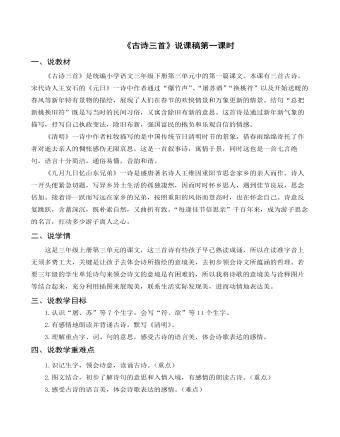
(说课稿)部编人教版三年级下册《古诗三首》第一课时
一、说教材《古诗三首》是统编小学语文三年级下册第三单元中的第一篇课文。本课有三首古诗。宋代诗人王安石的《元日》一诗中作者通过“爆竹声”、“屠苏酒”“换桃符”以及开始送暖的春风等新年特有景物的描绘,展现了人们在春节的欢快情景和万象更新的情景。结句“总把新桃换旧符”既是写当时的民间习俗,又寓含除旧布新的意思。这首诗是通过新年新气象的描写,抒写自己执政变法,除旧布新,强国富民的抱负和乐观自信的情感。《清明》一诗中作者杜牧描写的是中国传统节日清明时节的景象,借春雨绵绵寄托了作者对逝去亲人的惆怅感伤无限哀思。这是一首叙事诗,寓情于景,同时这也是一首七言绝句,语言十分简洁,通俗易懂,音韵和谐。
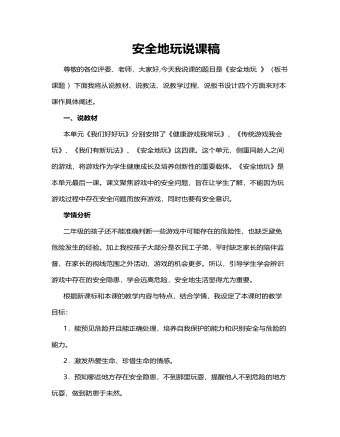
人教部编版道德与法制二年级下册安全地玩说课稿
任务1:(课件出示教材第32页图片)师:你们有没有面临过这样的危险,今后又要如何做呢?学生活动:学生讨论交流。教师小结:我们不仅要让自己远离危险,还要提醒他人注意安全。活动三:我们的安全提示牌任务1:我们在公共场所都见过安全提示牌,你觉得我们在学校的哪些地方也应该放置安全提示牌呢?学生活动:学生分组讨论。任务2:你认为安全提示牌上应写些什么话好呢?学生活动:学生讨论交流。任务3:除了学校,其他地方需要放置安全提示牌吗?请同学们试着制作一些安全提示牌。学生活动:学生制作安全提示牌,并放置在相应位置。课堂小结:通过本节课的学习,我们不仅发现玩耍的地方潜藏着危险,而且能够很好地认识到危险的程度,做到在保护自己的同时,提醒他人防范危险。
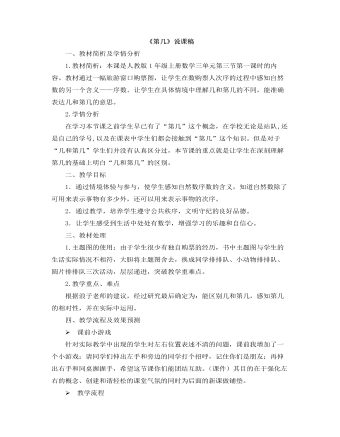
小学数学人教版一年级上册《第几》说课稿
一、教材简析及学情分析1.教材简析:本课是人教版1年级上册数学三单元第三节第一课时的内容。教材通过一幅旅游窗口购票图,让学生在数购票人次序的过程中感知自然数的另一个含义——序数。让学生在具体情境中理解几和第几的不同,能准确表达几和第几的意思。2.学情分析在学习本节课之前学生早已有了“第几”这个概念,在学校无论是站队,还是自己的学号,以及在课表中学生们都会接触到“第几”这个知识。但是对于“几和第几”学生们并没有认真区分过,本节课的重点就是让学生在深刻理解第几的基础上明白“几和第几”的区别。二、教学目标1.通过情境体验与参与,使学生感知自然数序数的含义,知道自然数除了可用来表示事物有多少外,还可以用来表示事物的次序。2.通过教学,培养学生遵守公共秩序,文明守纪的良好品德。3.让学生感受到生活中处处有数学,增强学习的乐趣和自信心。三、教材处理1.主题图的使用:由于学生很少有独自购票的经历,书中主题图与学生的生活实际情况不相符,大胆将主题图舍去,换成同学排排队、小动物排排队、圆片排排队三次活动,层层递进,突破教学重难点。
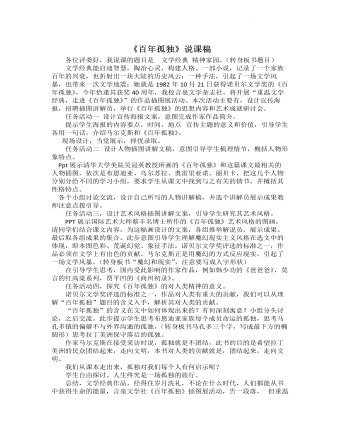
《百年孤独(节选)》说课稿 2022-2023学年统编版高中语文选择性必修上册
各位评委好,我说课的题目是 文学经典 精神家园。(转身板书题目)文学经典能启迪智慧,陶冶心灵,构建人格。一部小说,记录了一个家族百年的兴衰,也折射出一块大陆的历史风云;一种手法,引起了一场文学风暴,也带来一次文学地震;她就是1982年10月21日获得诺贝尔文学奖的《百年孤独》,今年恰逢其获奖40周年,我校言泉文学杂志社,将开展“重温文学经典,走进《百年孤独》”的作品插图展活动。本次活动主要有,设计宣传海报,招聘插图讲解员,举行《百年孤独》的思想内容和艺术成就研讨会。任务活动一 设计宣传海报文案,意图完成作家作品简介。提示学生海报的内容要点,时间,地点 宣传主题的意义和价值,引导学生各用一句话,介绍马尔克斯和《百年孤独》。现场设计,当堂展示,择优录取。任务活动二 设计人物插图讲解文稿,意图引导学生梳理情节,概括人物形象特点。

小学美术人教版六年级下册《第9课图文并茂3》教学设计说课稿
2重点难点教学重点第一课时:了解绘画故事的表现特点,感受真、善、美。第二课时:绘画自编故事的创作特点及步骤。教学难点第一课时:选材、构思设计。第二课时:构图与绘制3教学过程3.1 第一课时教学活动活动1【导入】“连连看” 教师提供数张图片和几句话(或几段文字),请学生根据文字找到相应的图画将它们连起来,并找出先后顺序将故事讲完整。教师小结,出示课题《图文并茂》。设计意图:以游戏的形式“连一连”,激发学生的好奇心和兴趣,以饱满的热情投入学习内容——图文并茂。
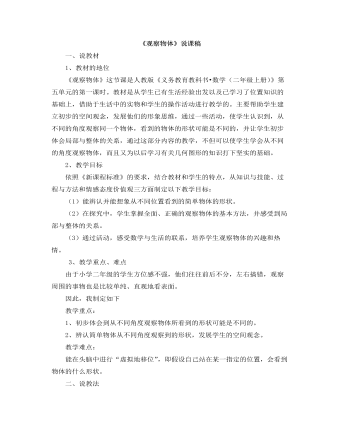
小学数学人教版二年级上册《观察物体》说课稿
1、教材的地位《观察物体》这节课是人教版《义务教育教科书?数学(二年级上册)》第五单元的第一课时。教材是从学生已有生活经验出发以及已学习了位置知识的基础上,借助于生活中的实物和学生的操作活动进行教学的。主要帮助学生建立初步的空间观念,发展他们的形象思维,通过一些活动,使学生认识到,从不同的角度观察同一个物体,看到的物体的形状可能是不同的,并让学生初步体会局部与整体的关系,通过这部分内容的教学,不但可以使学生学会从不同的角度观察物体,而且又为以后学习有关几何图形的知识打下坚实的基础。 2、教学目标依照《新课程标准》的要求,结合教材和学生的特点,从知识与技能、过程与方法和情感态度价值观三方面制定以下教学目标:(1)能辨认并能想象从不同位置看到的简单物体的形状。 (2)在探究中,学生掌握全面、正确的观察物体的基本方法,并感受到局部与整体的关系。 (3)通过活动,感受数学与生活的联系,培养学生观察物体的兴趣和热情。3、教学重点、难点由于小学二年级的学生方位感不强,他们往往前后不分,左右搞错,观察周围的事物也是比较单纯、直观地看表面。
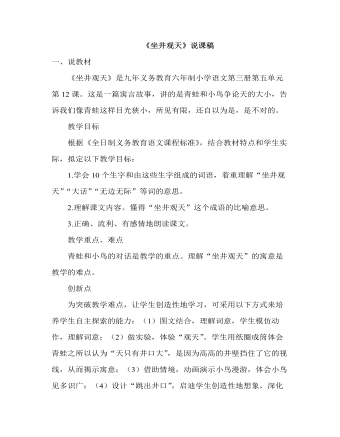
部编人教版二年级上册《坐井观天》说课稿
一、说教材《坐井观天》是九年义务教育六年制小学语文第三册第五单元第12课。这是一篇寓言故事,讲的是青蛙和小鸟争论天的大小,告诉我们像青蛙这样目光狭小,所见有限,还自以为是,是不对的。教学目标根据《全日制义务教育语文课程标准》,结合教材特点和学生实际,拟定以下教学目标:1.学会10个生字和由这些生字组成的词语,着重理解“坐井观天”“大话”“无边无际”等词的意思。2.理解课文内容。懂得“坐井观天”这个成语的比喻意思。3.正确、流利、有感情地朗读课文。教学重点、难点青蛙和小鸟的对话是教学的重点。理解“坐井观天”的寓意是教学的难点。创新点为突破教学难点,让学生创造性地学习,可采用以下方式来培养学生自主探索的能力:(1)图文结合,理解词意,学生模仿动作,理解词意;(2)做实验,体验“观天”。学生用纸圈成筒体会青蛙之所以认为“天只有井口大”,是因为高高的井壁挡住了它的视线,从而揭示寓意;(3)借助情境,动画演示小鸟漫游,体会小鸟见多识广;(4)设计“跳出井口”,启迪学生创造性地想象,深化认识。
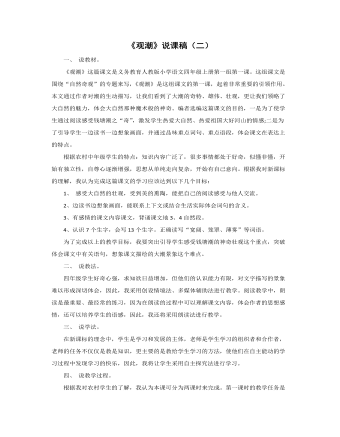
(新)部编人教版四年级上册 《观潮》说课稿(二)
一、 说教材。《观潮》这篇课文是义务教育人教版小学语文四年级上册第一组第一课。这组课文是围绕“自然奇观”的专题来写,《观潮》是这组课文的第一课,起着非常重要的引领作用。本文通过作者对潮的生动描写,让我们看到了大潮的奇特、雄伟、壮观,更让我们领略了大自然的魅力,体会大自然那种魔术般的神奇。编者选编这篇课文的目的,一是为了使学生通过阅读感受钱塘潮之“奇”,激发学生热爱大自然、热爱祖国大好河山的情感;二是为了引导学生一边读书一边想象画面,并通过品味重点词句、重点语段,体会课文在表达上的特点。根据农村中年级学生的特点:知识内容广泛了,很多事情都处于好奇,似懂非懂,开始有独立性,自尊心逐渐增强,思想从单纯走向复杂,开始有自己意向。根据我对新课标的理解,我认为完成这篇课文的学习应该达到以下几个目标:1、 感受大自然的壮观,受到美的熏陶,能把自己的阅读感受与他人交流。2、边读书边想象画面,能联系上下文或结合生活实际体会词句的含义。3、有感情的课文内容课文,背诵课文地3、4自然段。4、认识7个生字,会写13个生字。正确读写“宽阔、笼罩、薄雾”等词语。为了完成以上的教学目标,我要突出引导学生感受钱塘潮的神奇壮观这个重点,突破体会课文中有关语句,想象课文描绘的大潮景象这个难点。

